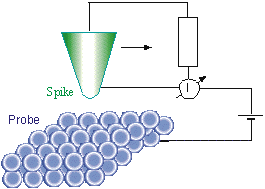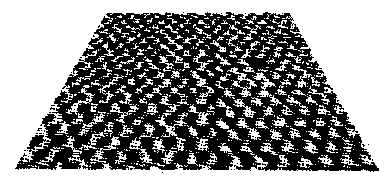The Raster Tunnel Microscope
Source: according to Kuhn Physik 2, p.325 (1st issue 2000)
The voltage is applied between two separated conductors that have contact between each other. The barrier of potential between the two conductors is located in ultra-high vacuum. The tunnel current is exponentially proportional to the potential barrier width. This tunnel current dependence is applied in the construction of new microscope which is better than any known microscope in the size resolution. The raster tunnel microscope which has been developed by G.Binning and H. Rohrer (who were awarded by the Nobel prize in 1986) can directly produce atomic structures.
 |
 |
| Fig. 1: The principle scheme of raster tunnel microscope. | Fig. 2: The "smallest hall of the World" : the picture taken by raster tunnel microscope on the MoS2-surface in which one atom is out (source: W.Heckl, LMU München) |
Beside one can raster the thin spike to surface of observed material. The
distance between the spike and surface can be precisely adjusted. The spike is
stopped when the tunnel current between spike and surface begins to flow. When
making measurements is constantly adjusted in a way that the tunnel current must
be constant. So, the spike is always on the same distance from surface. (The
local defects can simulate erroneous topology.) When measuring the spike
distance from surface one is also obtain the surface profile. This method is so
sensitive that it's possible to adjust single atoms on the observable surface.